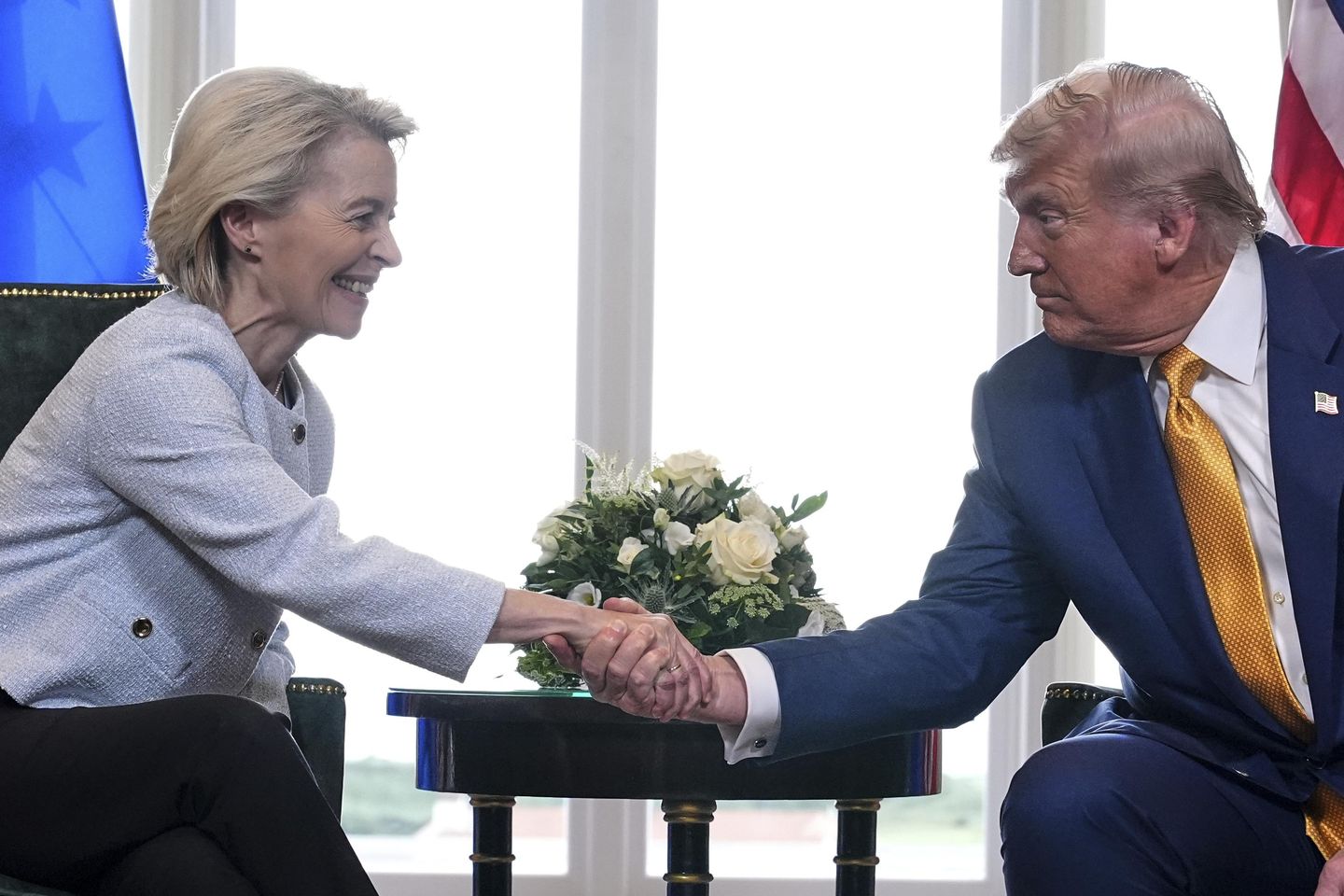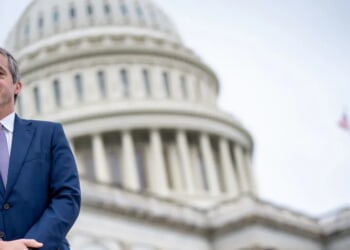
The United States and the European Union have narrowly avoided a trade war, agreeing to the framework of a deal that will open up European markets to U.S. goods and place a 15% tariff on EU products entering the U.S.
President Trump and European Commission President Ursula von der Leyen announced the accord Sunday in Turnberry, Scotland. It followed intense negotiations that sought to avert Mr. Trump’s threat to slap a 30% tariff on EU goods on Friday, which would have provoked trade retaliation by EU nations.
The president celebrated the agreement, which includes other benefits for the United States.
Under the terms of the deal, Europe will purchase $750 billion in energy products from the United States, invest $600 billion in the U.S. and purchase “a vast amount” of American military equipment.
“I think it’s the biggest deal ever made,” Mr. Trump said, adding that it was “a good deal for everybody.”
Ms. von der Leyen said the negotiations aimed to correct a trade imbalance in which the United States suffered a trade deficit with its largest trading partner, the bloc of 27 EU nations.
SEE ALSO: Trump urges EU leaders to stop building windmills
“We wanted to rebalance trade relations and we wanted to do it in a way that trade goes on between the two of us across the Atlantic,” she said.
The accord was reached just days ahead of a Friday deadline when Mr. Trump plans to slap “Liberation Day” tariffs on nations that have not secured new trade agreements with the U.S.
Under the EU deal, Mr. Trump said, tariffs on many U.S. goods would be cut from less than 3% to zero. Full details of the accord were not immediately available.
Mr. Trump and Ms. von der Leyen announced the breakthrough after a brief private meeting at the president’s Turnberry golf course in Scotland. The sit-down capped months of negotiations.
The trade deal with the EU is among a slew of new trade agreements announced by Mr. Trump in recent days as he rebalances global trade terms that he said have economically damaged the United States for decades.
The U.S. trade deficit with the European Union was $235.6 billion in 2024, a 12.9% increase over 2023, according to the Office of the U.S. Trade Representative.
In February, Mr. Trump said the EU trading bloc was “formed to screw the United States.”
He’s now reset the terms drastically in favor of the United States and has done so with half a dozen other countries, bringing in $27 billion to the U.S. Treasury along the way.
The president has negotiated arrangements with Britain, Indonesia, Japan, the Philippines and Vietnam that knock down tariff rates in exchange for investments or greater market access in those countries.
The U.S. and China in May agreed to lower some tariffs by 115% while leaving the door open for talks on new market access for American goods.
The Trump administration is sending a delegation to Stockholm next week to continue talks with China amid a 90-day pause in tariffs on many Chinese goods that will expire August 12.
The United States is also in talks with South Korea on a new trade agreement. Trump administration officials have been negotiating new terms with Mexico and Canada, although those talks have been less productive.
It wasn’t clear on Sunday whether U.S. concessions were made with the EU nations as part of the deal.
“I think we hit exactly the point we wanted to find — rebalance, but enable trade on both sides, which means good jobs on both sides of the Atlantic, prosperity on both sides of the Atlantic. And that was important to us,” Ms. Von der Leyen said when asked about U.S. concessions.
The 15% rate will apply to automobiles, but pharmaceuticals were not included in the deal, and tariffs on steel and aluminum will remain at 50%.
Mr. Trump said he wants prescription drugs to be made in the United States.
“Pharmaceuticals are very special. We can’t be in a position where we’re relying on other countries,” Mr. Trump said. “Europe is going to make pharmaceuticals, drugs and everything else for us, too. A lot. But we’re going to have also our own.”
Sunday’s announcement followed predictions by European Union leaders that the chances of reaching a deal on Sunday were only “50-50.”
Mr. Trump resisted efforts by EU leaders to lower their tariff rate to 10%, which is the rate the president agreed to set earlier this year on most goods imported from the United Kingdom.
Mr. Trump plans to hammer out additional details of a trade deal with the U.K. when he meets with Prime Minister Keir Starmer on Monday.



![Former Bravo Star Charged After Violent Assault Using a Rock-Filled Sock in Tennessee Walmart [WATCH]](https://www.right2024.com/wp-content/uploads/2025/07/Former-Bravo-Star-Charged-After-Violent-Assault-Using-a-Rock-Filled-350x250.jpg)



![NYC Man Snatches Child Off The Sidewalk, Parents Chase Him Down [WATCH]](https://www.right2024.com/wp-content/uploads/2025/07/NYC-Man-Snatches-Child-Off-The-Sidewalk-Parents-Chase-Him-350x250.jpg)
![Karoline Leavitt Levels CNN's Kaitlan Collins and Other Legacy Media Reporters [WATCH]](https://www.right2024.com/wp-content/uploads/2025/07/Karoline-Leavitt-Levels-CNNs-Kaitlan-Collins-and-Other-Legacy-Media-350x250.jpg)
![Man Arrested After Screaming at Senators During Big Beautiful Bill Debate [WATCH]](https://www.right2024.com/wp-content/uploads/2025/06/Man-Arrested-After-Screaming-at-Senators-During-Big-Beautiful-Bill-350x250.jpg)






